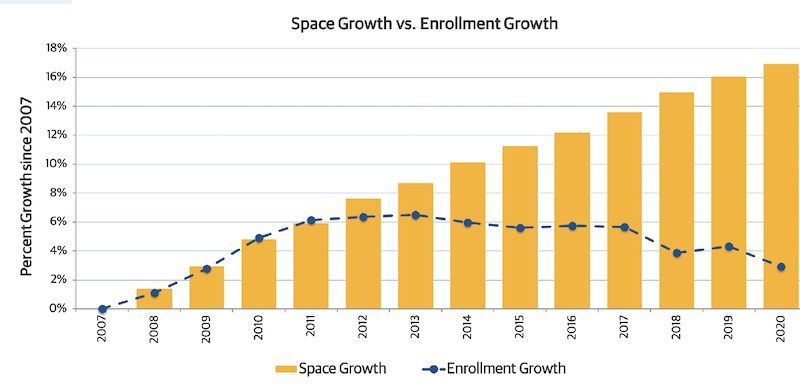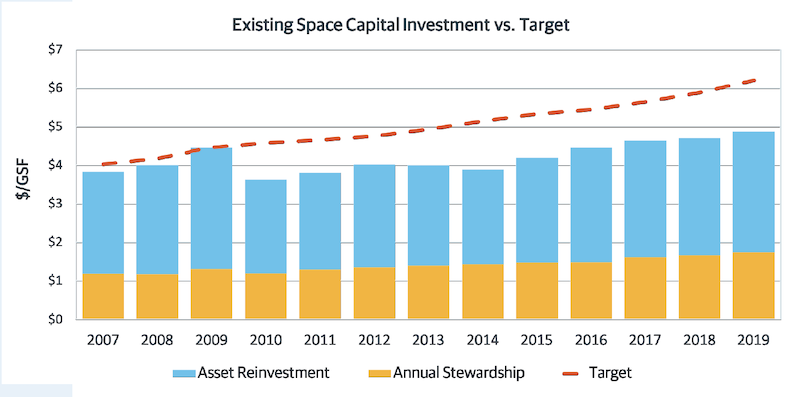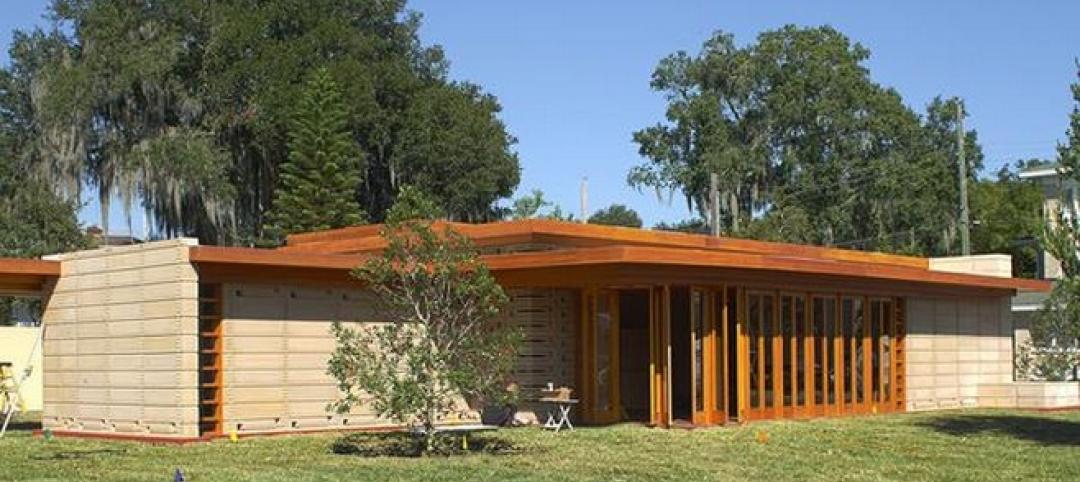As a result of the coronavirus pandemic, higher education is confronting its history of questionable facilities investment decisions and an unprecedented transformation on campuses that has made it imperative to reimagine construction, space allocation, and sustainability.
Gordian, a leading provider of facility and construction cost data, software, and services, analyzes the complexities of this transformation in the latest edition of its State of Facilities in Higher Education report, which this year Gordian conducted with APPA, an organization that represents more than 18,000 educational facilities professionals from over 1,300 learning institutions.
The report advocates for the increasing relevance of facilities managers at a time when campuses are building more space (schools in Gordian’s database were up 16% since 2007), but have also ill-advisedly deferred renovation on existing buildings, to the point where their backlog of asset renewal has increased by 35% since 2007, and their investment shortfall grew to 25%.

Colleges in Gordian's database have increased their space by 16% since 2007, but their student enrollment has increased only 2%. Images: Gordian and APPA
HOW MUCH SPACE WILL BE REQUIRED?
The pandemic has disrupted institutional improvement budgets by reducing student enrollment and shifting learning to remote and digital platforms that have lessened the need for campus spaces such as offices, dining halls, and residences. Outdoor spaces “were the rare bright spot, when weather has allowed,” the report states.
Consequently, campus planners are raising questions about what kinds of spaces will be needed in the future, and why. But adaptively reusing campus space is easier said than done. “Facilities offices aren’t sized and organized to maintain, clean and renovate according to student and staff activity. Rather, these offices maintain campus buildings independent of activity level,” the report observes.
Finding ways to fund facilities improvements and upgrades won’t be simple, either. The American Council on Education projects that the industry needs at least $180 billion to offset revenue losses and COVID-related expenses to maintain safe operations during the pandemic. But with between 50% and 70% of campus expenditures earmarked for employee compensation, the opportunities for addressing budget shortfalls without touching staffing are limited. For the whole of 2020, the industry lost 650,000 jobs.

Backlogs of campuses' asset renewal needs have grown to $106 per gross sf, and 35% increase since 2007.
WHAT DOES ‘COMMUNITY’ MEAN TODAY?
The report notes that in the 2020 fall semester, 44% of schools were fully or primarily online, with another 21% operating in hybrid teaching mode. However, Gordian and APPA contend that the virtual world is not yet able to replace the in-person [educational] experience. “Community continues to be reliant on the physical gatherings of people, which will be an expected element of the collegiate experience for some time to come.”
If schools can’t provide this meaningful engagement, as well as some demonstrable evidence of a return on students’ investment, enrollments will continue to drop. The 13% decline in last year’s incoming freshman class “will have a ripple effect across the next three to five years,” the report states.
And schools can no longer rely on international students to help bridge their financial gaps.
The whole concept of campus “community” is changing. And the sudden embrace of digital tools for teaching opens endless interpretations of what an academic community looks like. “An opportunity clearly exists to reimagine campus space. The window is open to embrace digital, distant and trust-based work environments, and [schools] should leap to take advantage of the moment.”
More to the point, “the data say we need to use less space because [schools] simply can’t care for what [they’ve] built,” says the report.

The investment shortfall in existing campus facilities has grown to 25% over the past 13 years.
HARD CHOICES WILL BE NECESSARY
So what are colleges and universities to do?
A start would be to document real operating costs, including the accrual of deferred needs with altered staffing and reduced capital investment. Facilities managers must prioritize space going forward, and clarify how students are likely to be taught. “Create a coherent narrative, incorporating the expectations of the community and the demands of the facilities, that represents a shared agreement for how to best optimize service to academic aspirations and institutional mission.”
Regarding future investments, schools must define their risk tolerances, especially it comes to keeping building systems operable to avoid shutdowns. Finance and facilities leaders must jointly understand how best to invest in a school’s physical plant, and develop a suitable investment strategy based on future need. That strategy, states the report, should have buy-in from the school’s senior leadership as well as stakeholders—students, faculty, workers—who will be affected by those decisions.
To meet the challenges of more dynamic campuses with fluid spaces and use, the report suggests that, at a minimum, institutions need to honestly appraise their facilities management teams, and determine what skills they will need for the next crisis but also routine times.
“Assess the type or work that has been required and is anticipated to be required to match hiring practices with the skills of the future,” the report states.
Related Stories
| Oct 31, 2013
74 years later, Frank Lloyd Wright structure built at Florida Southern College
The Lakeland, Fla., college adds to its collection of FLW buildings with the completion of the Usonian house, designed by the famed architect in 1939, but never built—until now.
| Oct 30, 2013
11 hot BIM/VDC topics for 2013
If you like to geek out on building information modeling and virtual design and construction, you should enjoy this overview of the top BIM/VDC topics.
| Oct 28, 2013
Urban growth doesn’t have to destroy nature—it can work with it
Our collective desire to live in cities has never been stronger. According to the World Health Organization, 60% of the world’s population will live in a city by 2030. As urban populations swell, what people demand from their cities is evolving.
| Oct 18, 2013
Meet the winners of BD+C's $5,000 Vision U40 Competition
Fifteen teams competed last week in the first annual Vision U40 Competition at BD+C's Under 40 Leadership Summit in San Francisco. Here are the five winning teams, including the $3,000 grand prize honorees.
| Oct 18, 2013
Researchers discover tension-fusing properties of metal
When a group of MIT researchers recently discovered that stress can cause metal alloy to fuse rather than break apart, they assumed it must be a mistake. It wasn't. The surprising finding could lead to self-healing materials that repair early damage before it has a chance to spread.
| Oct 15, 2013
15 great ideas from the Under 40 Leadership Summit – Vote for your favorite!
Sixty-five up-and-coming AEC stars presented their big ideas for solving pressing social, economic, technical, and cultural problems related to the built environment. Which one is your favorite?
| Oct 7, 2013
10 award-winning metal building projects
The FDNY Fireboat Firehouse in New York and the Cirrus Logic Building in Austin, Texas, are among nine projects named winners of the 2013 Chairman’s Award by the Metal Construction Association for outstanding design and construction.
| Oct 7, 2013
Geothermal system, energy-efficient elevator are key elements in first net-zero public high school in Rhode Island
The school will employ a geothermal system to heat and cool a portion of the building. Other energy-saving measures will include LED lighting, room occupancy sensors, and an energy-efficient elevator.
| Sep 24, 2013
8 grand green roofs (and walls)
A dramatic interior green wall at Drexel University and a massive, 4.4-acre vegetated roof at the Kauffman Performing Arts Center in Kansas City are among the projects honored in the 2013 Green Roof and Wall Awards of Excellence.
| Sep 19, 2013
What we can learn from the world’s greenest buildings
Renowned green building author, Jerry Yudelson, offers five valuable lessons for designers, contractors, and building owners, based on a study of 55 high-performance projects from around the world.

















